When a something in my needlework tool box starts to annoy me, I remove it. If it’s a tool that provides a service I need, I think of improvements to it, so that it doesn’t annoy me.
For example, I have a little pin cushion that works great for me outside my sewing box. But inside my sewing box, it Drives Me Nuts because it has a magnet on it, and the magnet catches on my scissors, my clips, or anything else it can suck into its Area of Attraction.
When my little magnetic pin cushion is stuck on my light pole by my stitching spot, it’s great. When it’s in my tool box creating havoc, it’s not. So I decided to pitch it in favor of something better.
And that something better was a quick little pincushion I whipped up in about 15 minutes. And you can do the same thing for your tool box or stitching area, too! I’ll show you how I did it…
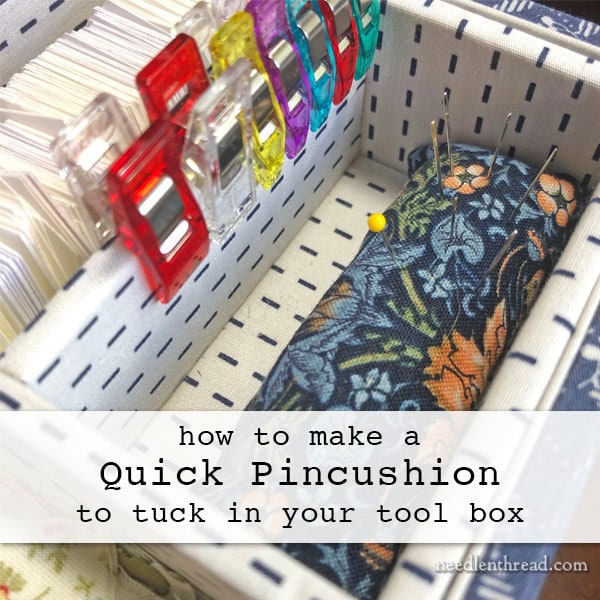
As I take you through this quick little tutorial, I’ll note some things that I would change, now that I’ve got the pin cushion in place.
I’ll also point out areas where you don’t want to cut corners, and areas where you can cut corners.
Materials for a Quick Pin Cushion
These are the materials I used to make my quick pin cushion:
Fabric for the outside
Fabric for the inside
Emery sand
Fiberfill
It helps to have various tools on hand: paper scissors, fabric scissors, some scrap paper, a ruler, some pins, a spoon, and something blunt and long that can be used for turning and stuffing.
Fabric
I didn’t have a lot of fabric to choose from, but you only need enough to make a small tube – less than a 5″ square, for the tube I made.
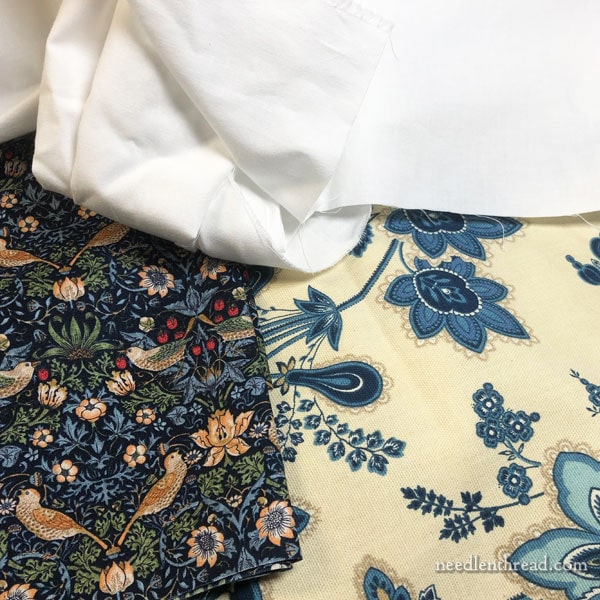
These are the only decorative fabrics I had on hand, aside from the quilting fabric I’m using on a quilt right now (which I wrote about the other day, here).
The fabric on the left is a quilting weight cotton in a Morris design (love this!) and the fabric on the right is a upholstery weight fabric in a nice Jacobean design on pale yellow with blues.
Either fabric works, as far as “matching” the sewing box I’m using. But your pin cushion doesn’t have to match. You can just use what you have on hand.
For the inside emery sack (if you use emery sand), you’ll need a high thread count cotton.
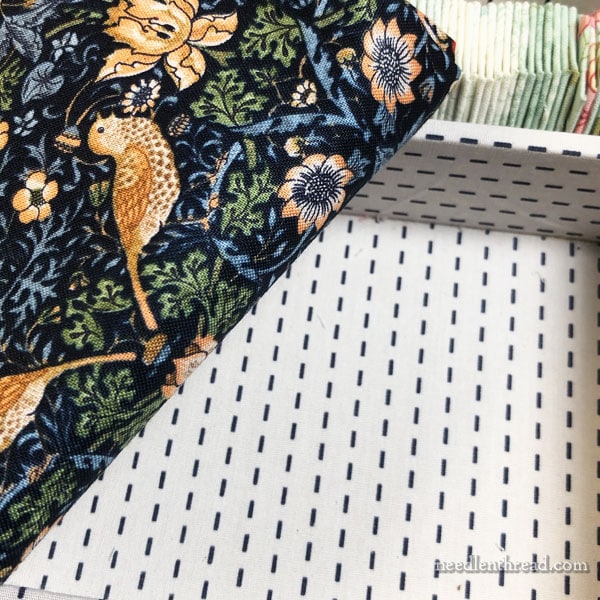
I picked this fabric. It matches, but that’s not the reason I chose it, and it has a Huge Drawback for a pin cushion, in my opinion.
I didn’t choose the upholstery weight fabric because the item I’m making is quite small and it will be easier to turn the sewn casing (outside of the pin cushion) with a lighter fabric.
But the problem with the Morris fabric is that it is quite dark and it’s hard to see needles against a dark fabric. Still, it’s what I had, so it’s what I used.
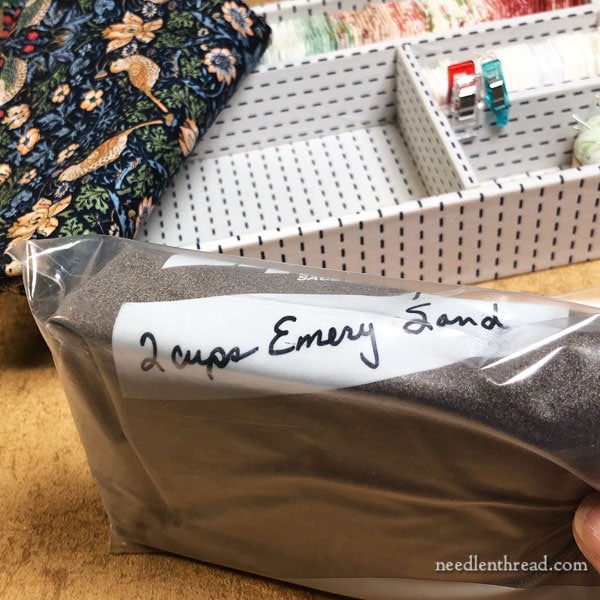
Emery sand is a gritty sand that’s used inside some pin cushions or pin cushion accessories (like the strawberry on a tomato pin cushion). It helps keep your needles and pins sharp.
However, it’s not the best stuff in the world to store needles in for a long time, which is why I used both emery and fiberfill in my pin cushion. If I had had it, I would have used a nice wool roving in the pin cushion instead of fiber fill, but I didn’t have any on hand. And this isn’t necessarily meant to be the world’s greatest and most effective pin cushion – it’s just supposed to be a quick solution pin cushion!
I bought this emery sand on Etsy. You can get it in different grits – I bought the 100 grit, but 80 will do fine, and in fact, it might do better, because it would be less prone to seep as it isn’t quite as fine.
You don’t need emery sand. You can just stuff your little cushion with fiber fill – in which case, you only need the outside fabric.
But I like the emery sand for two reasons: 1. it gives weight to the pin cushion; and 2. it provides a sharpening agent for my pins and needles.
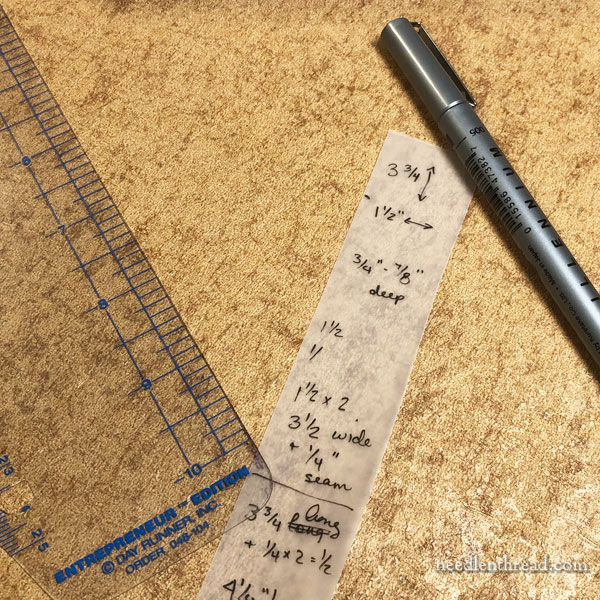
I measured the section of my tool box where I wanted my pin cushion to fit, to determine the size of fabric I wanted to cut.
My plan was to use one piece of outside fabric, and sew it up once on the long seam and then sew up the two short seams, to make a small tube.
I multiplied the top surface width times 2, added an extra 1/2″ or so for depth and then a 1/2″ for the seam allowances on two sides. I ended up cutting a piece that was 4.25″ long x 3.75″ wide.
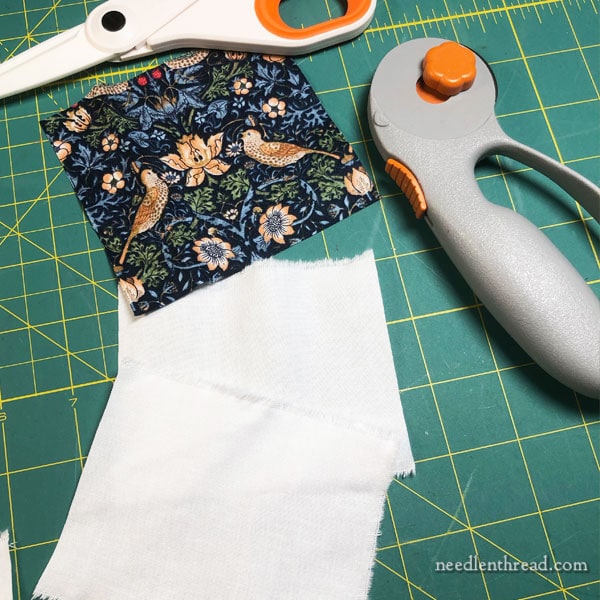
I cut two inside pieces of white, high thread count cotton for the inside emery sack, making it half an inch smaller. These two pieces are sewn together as if they are one piece, to give a double thickness to the emery sack. This helps prevent the sand from easily seeping. It’s essential to use two layers for the emery sack, so don’t cut corners here!
So, in summary, if you’re using emery sand, cut your outside fabric piece the size you need to create the “tube” size you want for your pin cushion. Then cut two pieces of inside fabric 1/2″ smaller than the outside in both length and width.
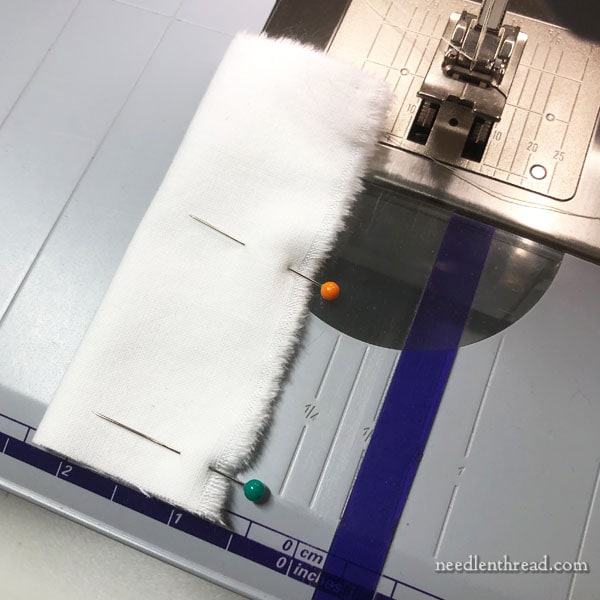
Stack the two pieces of inside fabric, and sew the long seam and one short seam, leaving one short end open for turning and filling.
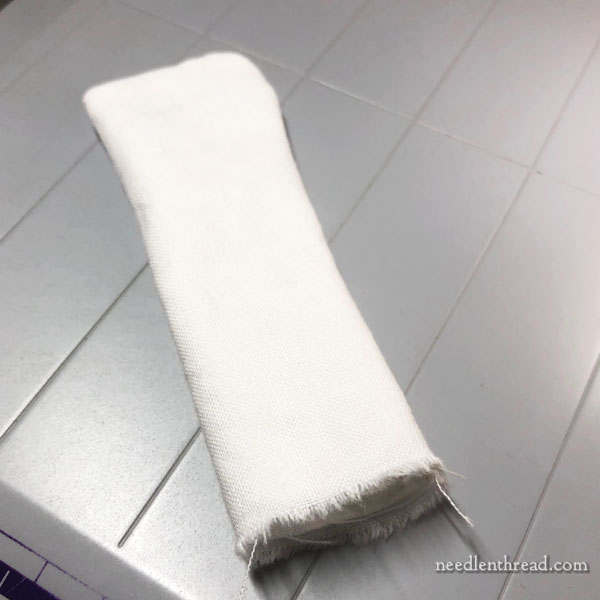
After you sew the seams, trim the seam allowance a little and turn the tube inside out.
You don’t have to be too persnickety with this inside emery sack. No one will ever see it. So if it isn’t perfect, don’t fret!
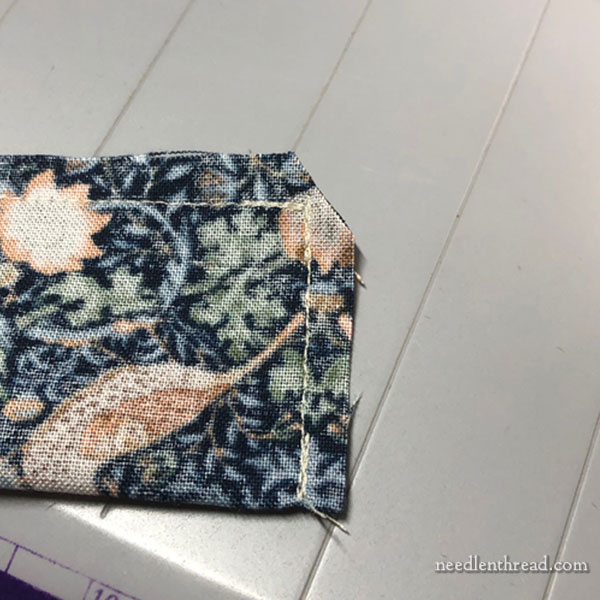
While you’re at the sewing machine, sew the outside of the pin cushion the same way – down the long seam and across one short end seam. Trim the corner a little, as shown above, so that the corner when it’s turned out is a little neater.
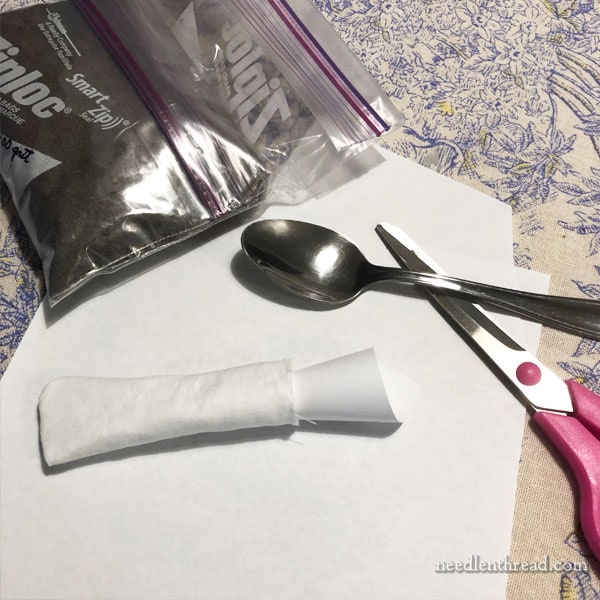
Working over a piece of scrap paper, using a spoon and a small paper funnel made from scrap paper, fill the inside tube with emery sand. You don’t have to fill it packed full – just fill it enough to fill the shape.
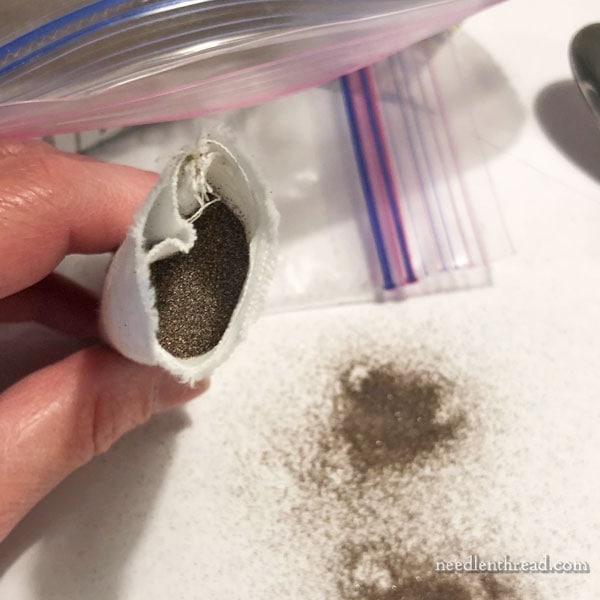
On a piece this size, it’s not going to take much emery sand.
You can see why it’s a good idea to work over some scrap paper. Any sand that over fills or spills can be poured back into your sand bag.
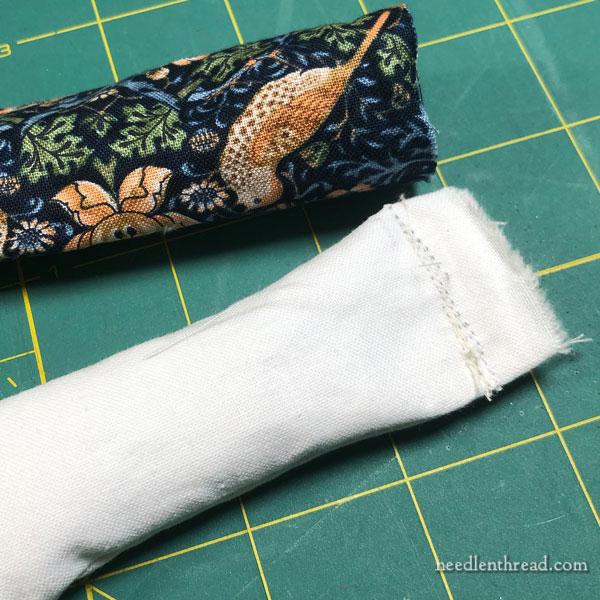
Being careful not to spill any of the sand, sew across the top of the emery sack. I went back and forth (using the reverse button), not being too neat.
It helps to sew a little bit away from the emery, so your presser foot on your machine isn’t having to climb that little mountain of sand – but if you want to sew closer to the emery, it might help to change to a zipper foot.
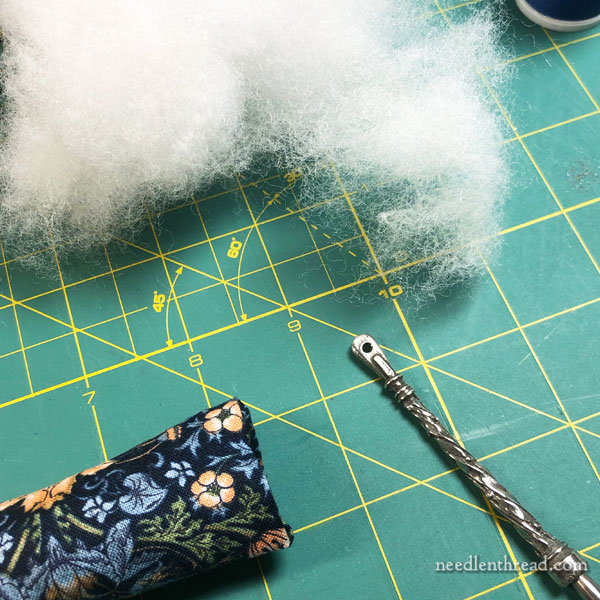
Trim the edge of the emery tube next to the sewing within a scant 1/8″, then slide the tube inside the outside fabric of the pin cushion.
Gather a bit of fiberfill and a blunt tool that you can use to push it into the tube.
Do not use a sharp tool – you don’t want to pierce the emery tube with anything that’s large and sharp, or you’ll loose your sand pretty quickly!
Stuff fiberfill into the tube on one side of the emery tube (and towards the up side of your pincushion, if it matters to you which side is up).
Work the pin cushion with your fingers, to manipulate the fiberfil into place and spread it out, so it isn’t lumpy. You want the whole pin cushion to be fairly tight, so stuff in more than you think you actually should, working in small bunches and working it down and smoothing it out by messaging the outside of the pin cushion as you stuff.
When you like the feel of it, and before the side seam starts pulling so that you can see your sewing stitches, stop stuffing!
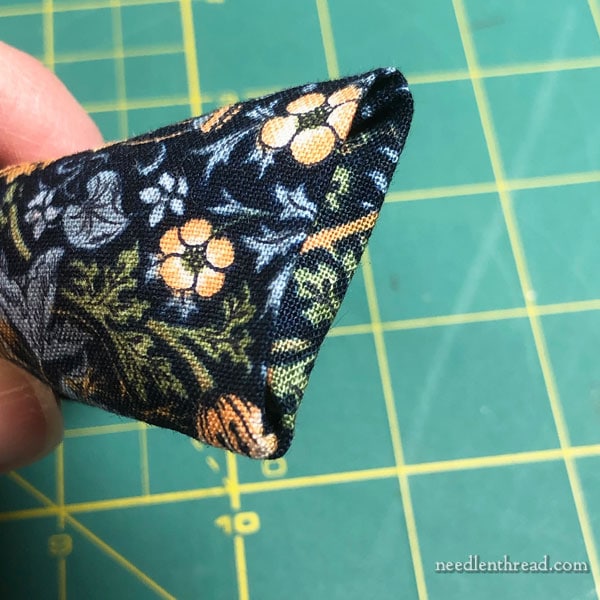
On the open side of the tube, fold the edges in, and using a coordinating thread color, work a blind slip stitch inside the edges to close the hole.
Voilá! You’re finished!
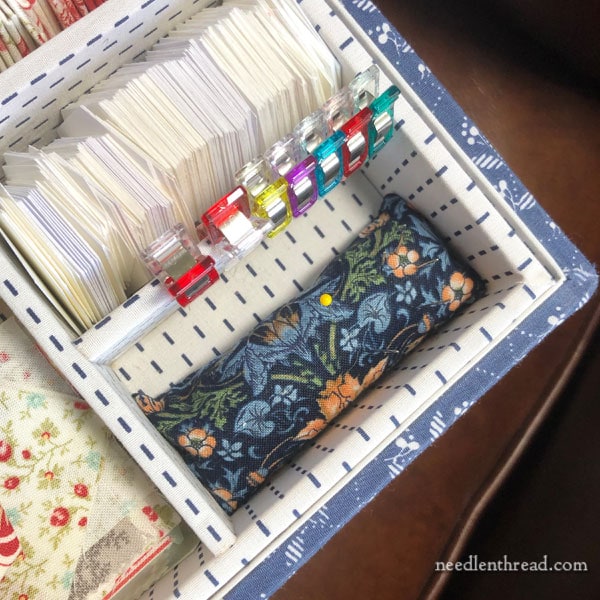
I made my pin cushion so that it tucks into this little section in my box. I can stick pins and needles just into the fiberfill layer on top, or I can go a little deeper into the emery layer.
The emery helps weight the cushion – a feature I like in a pin cushion – but it also serves to sharpen my pins and needles.
There are other fillings you can use to fill pin cushions, depending on what’s easy for you to come by: crushed walnut shells, wool roving, scraps of threads (orts) and other fibers that make sense.
One thing I’d do differently is use a lighter fabric, but I used what I had on hand. It’s easier to see pins and needles against a lighter fabric than it is against a darker fabric.
On this pin cushion, I use the yellow-headed pin to mark where I put my favorite sewing needle. I always slip it in right next to the yellow-headed pin.
This is a quick way to make a handy little pin cushion. The whole process, if you’re using a sewing machine, takes about 15 minutes.
If you’re in need of a little pin cushion, I hope today’s tutorial comes in handy for you!
Have a wonderful weekend!







You mentioned that it is NOT good to keep your needles in the emory for a long time… Why?
Well, I read – I haven’t experienced it – that needles stored for a long time in aluminum oxide can rust or corrode or what-have-you. I don’t know if this is true. I’ve also heard that pins left in polyfill can rust. Again, never experienced it. I’ve always tried to err on the safe side and use wool roving to stuff small pincushions, but I don’t have any on hand right now.
But, you know, this is The Thing: I use my needles so much that I regularly have to pitch them. They’re never really stuck in a pin cushion long enough to erode or rust or anything else, no matter what the pin cushion is made from. As far as long-term “where I keep my needles” – they’re usually kept in the original packaging until I take them out to use them. And once I take one out, I use it pretty much to death. When I stick it in a pin cushion, it’s only in there until the next time I’m stitching. Pretty much, 24 hours never passes, that I don’t have to pick up my needle. As for pins, they’re also kept in their original little boxes and whatnot, except for the ones on my sewing machine, which are on a big magnetic dish thingy to make it easier to quickly put them there and keep them there when I’m using the machine, which isn’t all that often. Occasionally, a pin or two gravitates into a pin cushion. Occasionally, my pin cushions will start to look full, because I’ve haphazardly stuck in pins or needles that are loose, from working on one project or another. So occasionally, when I’m straightening and re-organizing my work area, I cull out stuff from my big pin cushion on my work table.
I just haven’t had a chance to experience rusting needles from any pin cushion filling, but just in case, I still like to give my needles an option where to land – either in the emery or in the fiber filling, which, if I had it, wood have been wool roving.
Hello Mary,
As always, you do a wonderful job of describing exactly how to go about a project. I did not know about the emery in the strawberry on a traditional tomato pincushion! Always wondered why it was attached to the tomato. Thank you so much for an intriguing detail.
Best wishes,
Liz
I definitely need to make one of these pincushions! Maybe I will combine it with the pincushion from Y*Handmade’s post of 01/29/19 which has been on my mind. I’m actually considering leaving work right now to go home and get started… Daydreaming about it anyway!
Great little tutorial. And an excellent fabric choice (despite its being dark.) I say that because I made myself a blouse out of the same fabric.
Hi Mary,
Where did you find your William Morris fabric? That one is called Strawberry Thief. I wrote about this in a book and have never seen the fabric in real life. Morris designed it after watching thrushes eat his strawberries.
It’s a fairly available fabric line, I think. I got it at Sarah’s in Lawrence, Kansas, but I would imagine any higher end quilting fabric store has it. I think I got it at the end of last year (so, probably 6 months ago). They have a red version, too, which is the fabric I used for the back of my scissor fob in my Thousand Flowers project book.
I love pincushions-especially ones I make. I just finished a wool felt cardinal that turned out so lovely. It was a kit and they gave you wool roving to stuff with. I see many people are stuffing with sawdust but I never have. I usually use batting or fiberfill next to the fabric and in the inner part I use crushed walnut shells in a muslin pouch like you do with the emery. One of the big tips I got from someone was to put small amounts of stuffing into the corners first, then loft, loft and loft again your fiberfill before stuffing to avoid lumpiness. Then stuff until firm because over time the stuffing will settle and your pillow or pincushion will look deflated. I used those tips and my pincushions look so much better. I’ll have to make one like yours now.
I’ve made about a billion pincushions and I’ve learned 2 valuable things today. I gravitate towards darker fabric (I LOVE that William Morris fabric, btw) and you are absolutely right about not being able to see the pins and needles clearly against the dark background. And it has always aggravated me that I can’t quickly find my “favorite” needle once it going into the pincushion. An Anchor pin! That’s brilliant.
I ordered that DMC sewing box. AND the larger one. I am a sucker for sewing kits.
Thanks!
Lovely pincushion, thank you for explaining in detail how it was made 🙂
Cute pincushion, Mary! Thanks for the tip on using light colors. A friend told me about using parakeet gravel when you can’t get emery sand. It works great and is available wherever pet supplies are sold, which is about everywhere!
Love your little pincusion. I like to use wheatbran for filling. And add some dried valerian in the cushion. Gives a nice parfume in your sewingbox
I fear using anything food-based as a pin cushion filling, especially out here in Kansas, where we can get bugs in things. But I do like adding a few dried bits of lavender to a pin cushion, too. I’ve always wondered how dried verbena would do? I’ve never smelled valerian. I will have to look it up!
I made een error, did not mean Valerian but Lavender.
Thanks for your newsletter Mary, a pleasure every weeks to discover new technics, books or materials with so much interesting details! Do you know this kind of pins : Sewtites , some magnetic pins (easy and usefull)?
Best wishes.
You’ve intrigued me, Cecile – I have ordered a set! 🙂
A trip to some hardware stores will also reveal in the sandpaper section a product called Crocus Cloth. It’s a very fine grit sandpaper known to polish rust off needles and to sharpen points. The back of the somewhat flexible 9″x11″paper shows 3M as a manufacturer. I’ve cut circles from it to glue to lid surface of recycled film cannisters as well as top of a sewing thread spool in various thrifty sewing gifts, knowing most people more likely to throw away “bad” needles but that this would polish off the discoloration. I’m also a big fan of saffron, which comes from the stigmas of crocus flowers, so I keep thinking I’ll get around to embroidering those pretty purple flowers with their orange red stigmas to make something with a useful crocus cloth rubbing surface.
Thanks for this tutorial, great info!
I use solid-colored fabric for pincushions. Anytime I have used a pretty print fabric, I have had more trouble finding my pins and needles. Prints with lots of tiny flower petals are especially good at hiding pinheads!
So true, Natalie! LOL!
Which is the best for the needles? The emery or the crushed walnuts? Or is there something else that would be best for the needles. I find that my needles tend to rust.
Emery is good for “sanding” the needles and keeping them smooth – it’s a very fine grit. I don’t think the walnut shells work quite the same way.